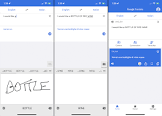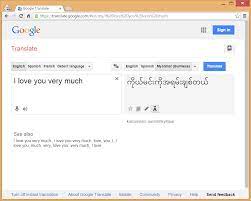Google Translate: Unlocking a World of Multilingual Communication
In today’s interconnected world, where global communication is more important than ever, language barriers can often hinder effective interaction. Thankfully, technology has come to the rescue with solutions like Google Translate, revolutionizing multilingual communication and making the world a smaller place.
Google Translate is a free online translation service developed by Google. With its user-friendly interface and powerful translation algorithms, it has become one of the most popular translation tools available today. Here’s why it stands out as one of the best:
Extensive Language Support:
One of the key strengths of Google Translate is its vast language coverage. It supports over 100 languages, ranging from widely spoken ones like English, Spanish, and Mandarin to lesser-known languages such as Welsh or Swahili. This extensive language support ensures that people from diverse linguistic backgrounds can benefit from this tool.
Accuracy and Reliability:
Over the years, Google Translate has significantly improved its translation accuracy. Powered by advanced machine learning algorithms and neural networks, it can produce translations that are remarkably close to human-level quality. While there may still be occasional errors or nuances that get lost in translation, Google Translate continues to refine its algorithms to provide increasingly accurate results.
Multiple Input Methods:
Google Translate offers various input methods to cater to different user preferences. Users can type or paste text directly into the interface for instant translation. Additionally, they can also upload documents or even take pictures of printed text using their smartphones for quick and convenient translations on-the-go.
Voice Input and Output:
For those who prefer spoken communication, Google Translate offers voice input and output capabilities in many languages. Users can speak into their device’s microphone and have their words instantly translated into another language. This feature is particularly useful for travelers or individuals engaging in real-time conversations with people who speak different languages.
Contextual Translation:
Understanding context is crucial for accurate translations, and Google Translate has made significant strides in this area. By analyzing surrounding text and considering the broader context of a sentence or phrase, it can provide more precise translations that reflect the intended meaning. This contextual understanding enhances the overall translation quality and improves comprehension for users.
Continuous Improvement:
Google Translate is constantly evolving and improving. With a vast user base worldwide, Google actively collects feedback from users to refine its translation algorithms. This feedback loop allows Google to identify areas of improvement, rectify errors, and introduce new features that cater to the changing needs of its users.
Integration with Other Tools:
Google Translate seamlessly integrates with other popular Google services, such as Chrome browser extensions or mobile apps. This integration enables users to translate web pages, emails, or even conversations within other applications without having to switch back and forth between different tools.
While Google Translate offers numerous benefits, it’s important to note that it may not be suitable for complex or highly specialized translations. In such cases, professional human translators are still essential for accurate results.
In conclusion, Google Translate has undoubtedly become one of the best translation tools available today. Its extensive language support, accuracy improvements over time, versatile input methods, contextual understanding capabilities, continuous improvement efforts, and integration with other tools make it an invaluable asset for multilingual communication in our increasingly globalized world. Whether you’re traveling abroad or simply seeking to connect with people from different linguistic backgrounds, Google Translate is a powerful ally that helps break down language barriers and fosters meaningful communication across cultures.
8 Frequently Asked Questions About the Best Google Translate App
- What is the best Google Translate app?
- How accurate is Google Translate?
- Does Google Translate work offline?
- What languages does Google Translate support?
- How much does Google Translate cost?
- Is there a limit to how much text I can translate with Google Translate?
- Are there any alternatives to Google Translate?
- Can I use voice input with Google Translate?
What is the best Google Translate app?
When it comes to the best Google Translate app, there are a few options available depending on your specific needs and preferences. Here are three popular choices:
Google Translate (Official App):
The official Google Translate app, available for both Android and iOS devices, offers a comprehensive set of features. It supports text translation in over 100 languages, voice input for translations, camera translation to instantly translate printed text, and offline translation for select languages. The app also provides additional features like phrasebook storage for easy access to frequently used translations and conversation mode for real-time bilingual conversations.
Microsoft Translator:
While not developed by Google, Microsoft Translator is a highly regarded translation app that competes with Google Translate. It supports text translation in over 70 languages, voice input and output capabilities, camera translation, and offline translation for select languages. Microsoft Translator also offers unique features like multi-person conversation translation and the ability to translate text on images.
iTranslate:
iTranslate is another popular choice among users seeking a reliable translation app. Available for both Android and iOS devices, it supports text translation in over 100 languages, voice input and output capabilities, camera translation, and offline mode for select languages. iTranslate also offers additional features like verb conjugation assistance and the ability to save favorite translations.
Ultimately, the best Google Translate app depends on individual preferences regarding user interface design, additional features offered, ease of use, and personal requirements. It’s worth exploring each of these apps to determine which one aligns best with your specific needs.
How accurate is Google Translate?
Google Translate has made significant improvements in accuracy over the years, thanks to advancements in machine learning and neural network technologies. However, it’s important to note that while Google Translate can provide helpful translations, it may not always produce completely accurate results.
The accuracy of Google Translate depends on various factors, such as the complexity of the text, the language pair being translated, and the context of the content. It tends to perform better with widely spoken languages that have extensive training data available.
For simple and common phrases or sentences, Google Translate generally offers reliable translations. However, for more complex or specialized content, such as technical documents or legal texts, its accuracy may be lower. In these cases, it is advisable to consult professional human translators who have expertise in the specific subject matter.
It’s also important to keep in mind that languages have nuances and cultural variations that automated translation tools might not fully capture. Translations can sometimes lose subtleties or idiomatic expressions that are unique to a particular language or culture.
To enhance accuracy and improve results, Google actively collects user feedback and continuously updates its algorithms. Users can contribute by reporting any translation errors they encounter through the platform.
While Google Translate is a valuable tool for quick translations and basic understanding of foreign languages, it’s always recommended to exercise caution and verify translations when accuracy is vital.
Does Google Translate work offline?
Yes, Google Translate offers an offline mode that allows users to access translations without an internet connection. This feature is particularly useful when traveling to areas with limited or no internet access.
To use Google Translate offline, you need to download the specific language packs you require beforehand. These language packs contain the necessary data for offline translation. Once downloaded, you can access translations even when you’re not connected to the internet.
It’s important to note that while offline mode provides basic translation functionality, some advanced features, such as camera translation or voice input/output, may not be available without an internet connection. Additionally, offline translations may not be as accurate or comprehensive as online translations due to the limitations of offline language packs.
To enable offline mode and download language packs in the Google Translate app, simply go to the app settings and select “Offline Translation.” From there, you can choose and download the languages you need.
Overall, Google Translate’s offline mode is a valuable feature that ensures translation accessibility even in situations where an internet connection is unavailable.
What languages does Google Translate support?
Google Translate supports a wide range of languages. As of now, it can translate text and provide language detection for over 100 languages. Some of the most commonly supported languages include:
- English
- Spanish
- French
- German
- Italian
- Portuguese
- Russian
- Chinese (Simplified and Traditional)
- Japanese
- Korean
In addition to these widely spoken languages, Google Translate also supports numerous other languages, including regional dialects and less commonly spoken ones such as Welsh, Swahili, Icelandic, and many more.
It’s worth noting that while Google Translate provides translation services for a vast number of languages, the quality and availability of certain features may vary depending on the language pair involved. The level of accuracy and available features may be higher for widely spoken languages compared to less commonly used ones.
Google continues to expand its language support and improve translation capabilities over time, aiming to make multilingual communication more accessible and seamless for users worldwide.
How much does Google Translate cost?
Google Translate is a free online translation service provided by Google. Users can access and utilize its features without any cost. Whether you’re translating text, documents, or even using the voice input/output capabilities, Google Translate remains free for personal use. However, it’s important to note that there may be additional costs associated with internet connectivity or data usage depending on your network provider and plan. Additionally, for businesses or organizations looking for more advanced translation solutions or integration options, Google offers enterprise-level services that come with their own pricing structures.
Is there a limit to how much text I can translate with Google Translate?
Yes, there is a limit to how much text you can translate with Google Translate. The maximum amount of text that can be translated in a single request is 5,000 characters. If you exceed this limit, you will need to split your text into smaller portions and translate them separately. It’s important to keep in mind that longer texts may also take more time to process and generate the translations.
Are there any alternatives to Google Translate?
Yes, there are several alternatives to Google Translate that offer their own unique features and strengths. Here are a few popular ones:
- Microsoft Translator: Developed by Microsoft, this translation tool offers support for a wide range of languages and provides accurate translations across various platforms, including web browsers, mobile apps, and even wearable devices. It also offers speech translation, real-time conversation translation, and offline translation capabilities.
- DeepL Translator: Known for its exceptional translation quality, DeepL Translator utilizes deep learning technology to provide highly accurate and natural-sounding translations. It supports multiple languages and offers a user-friendly interface for easy text input. DeepL Translator also integrates with popular web browsers and has an API available for developers.
- Yandex.Translate: Developed by Yandex, a Russian search engine company, Yandex.Translate offers translation services for over 90 languages. It provides both text and image translation capabilities and has additional features like dictionary definitions, synonyms, and voice input/output options.
- iTranslate: Available as a mobile app for iOS and Android devices, iTranslate offers instant translations across multiple languages. It supports voice input/output, offline mode for selected languages, and even offers specialized dictionaries for specific topics like business or travel.
- Babylon Translator: Babylon Translator is a comprehensive language tool that combines machine translation with access to professional human translators when needed. It provides accurate translations in various languages and also includes features like dictionary definitions, grammar checks, and language learning resources.
It’s worth mentioning that while these alternatives have their own strengths, no machine translation tool can match the precision and nuance of human translators in certain contexts. When it comes to complex or specialized content requiring cultural understanding or industry-specific terminology, professional human translators are still the preferred choice for accurate translations.
Can I use voice input with Google Translate?
Yes, Google Translate does support voice input. You can use the voice input feature to speak into your device’s microphone and have your words instantly translated into another language. This feature is particularly useful for real-time conversations or when you prefer to communicate verbally instead of typing. Simply open the Google Translate app or visit the website, select the languages you want to translate between, and tap on the microphone icon. Then, speak clearly into your device’s microphone, and Google Translate will transcribe and translate your words in real-time. It’s a convenient and efficient way to communicate across different languages.




